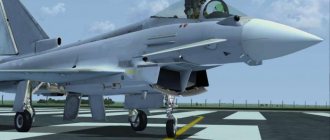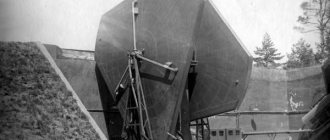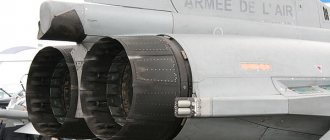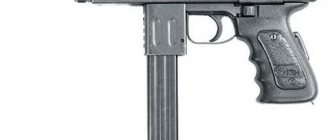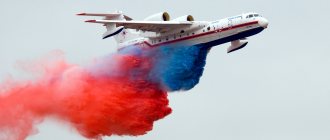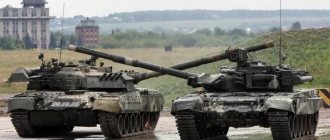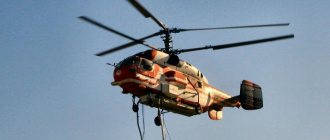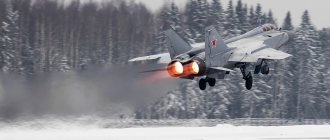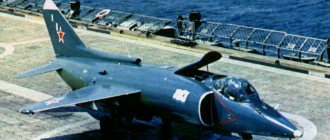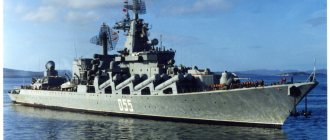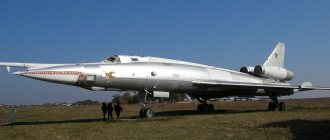Su-47 "Berkut"
(C-37) - experimental fighter of the Design Bureau named after. Sukhoi. The aircraft is considered primarily as an experimental aircraft, intended for flight testing of new technological solutions, demonstration of technologies and testing of elements of super-maneuverability. In the future, it should become a prototype of a super-maneuverable multi-role fighter.
Enlarge: Photo Su-47
"Berkut" is made according to the aerodynamic design of a "longitudinal integral triplane" with a forward-swept wing (SWS). The wing smoothly mates with the fuselage, forming a single load-bearing system. Features of the layout include developed wing flaps, under which are placed unregulated engine air intakes, having a cross-sectional shape close to a sector of a circle.
Chief designer - Mikhail Aslanovich Pogosyan.
Enlarge: Su-47 Berkut
The project developed first as a promising model of a fighter with a CBS for the USSR Air Force (modernization of the Su-27, topic S-37) as part of an industry research program since 1983, but this topic was closed in 1988. After this, the customer of the project was the USSR Navy, which predetermined the further development of the project as a promising aircraft for aircraft-carrying cruisers. The project was renamed and called Su-27KM (ship modified). Further, after the collapse of the USSR and the crisis in the country in the 1990s, state funding was removed from the project and it continued only thanks to the Sukhoi Design Bureau’s own funding. As a result, after all the vicissitudes, the aircraft was presented to the public under the name Su-47 Berkut.
The first flying example of the Su-47 was built in 1997; it is now experimental. In 2011-2012, two prototypes were created on its basis. The Su-47 was often called, if not the fifth generation fighter itself, then its prototype. The Su-47 is testing some of the technologies used on the PAK FA, such as internal weapon bays.
Photo of Su-47 "Berkut"
Enlarge: Su-47 fighter
Enlarge: Su-47
Enlarge: Su-47 at MAKS-2001
Enlarge: Su-47 at MAKS-2001
Enlarge: Su-47 at MAKS-2001
Enlarge: Su-47 at MAKS-2003
The history of the creation of the Su 47 fighter
Initially, the project was designated Su 37 and was intended for experimental development of a vehicle with a forward-swept wing. Chief designer of the project M.A. Pogosyan expected to develop a number of advanced technologies necessary to create a new generation of aircraft.
su 47 photos
In 1988, due to the shortsightedness of the military leadership of the USSR Air Force, the program ceased to exist. After some time, the USSR Navy showed interest in the experimental vehicle and the project was continued as a carrier-based fighter for aircraft-carrying cruisers under the designation Su-27KM . But even here he failed; the subsequent collapse of the Soviet Union and the financial crisis shifted the burden of responsibility for the continued existence of the project to the Sukhoi Design Bureau.
We must pay tribute to the OKB workers, the work, although with difficulty, progressed, and already in 1997, at the end of September, a machine under the designation Su-47 performed its first 30-minute flight. At the MAKS-1999 aviation exhibition, the aircraft was demonstrated to the general public, and at MAKS-2001 the Su-47 was named "Berkut" .
Design
The Su-47 "Berkut" is made according to the aerodynamic design of a "longitudinal integral triplane" with a forward-swept wing (SOS). The wing smoothly mates with the fuselage, forming a single load-bearing system. Features of the layout include developed wing flaps, under which are placed unregulated engine air intakes, having a cross-sectional shape close to a sector of a circle.
The wing of the Su-47 fighter has a developed root part (about 75°) and a variable sweep angle (about 10°) along the leading edge and a smoothly mating cantilever part with forward sweep (along the leading edge - about 20°). The wing is equipped with flaperons, occupying more than half the span, as well as ailerons. The all-moving front horizontal tail (PGO) with a span of about 3.5 m has a trapezoidal shape. Its sweep angle along the leading edge is about 50°. The rear horizontal tail of a relatively small area is also made all-moving, with a sweep angle along the leading edge of about 75°.
Enlarge: Su-47 at MAKS-2005
Interesting facts about the Su 47 fighter
The Su 47 is used as a flying laboratory; many developments in the research process of this machine formed the basis for the use of the fifth generation aircraft T-50 .
Su 47 Berkut
"Berkut" is the first Russian aircraft with a forward-swept wing, which is recognized as promising, unlike similar projects of Western designers.
An interesting story occurred after the publication by Vozdushny Vestnik of a photograph from a meeting of the Military Council, where on the table there was a model of the Berkut with the characteristic shape of a forward-swept wing. Before this, the design bureau’s management generally denied the existence of such an aircraft, but Western experts were able to prepare drawings of this promising aircraft from the photograph.
Avionics
The project assumed that the Su-47 Berkut would use the most modern on-board equipment - a digital multi-channel DESU (analog on the first aircraft), an automated integrated control system, a navigation complex, which includes an INS on laser gyroscopes in combination with a satellite navigation and “digital map”, which have already found application on such machines as the Su-30MKI, Su-34 and Su-27M. It was planned to equip it with an integrated life support and crew ejection system of a new generation.
To control the aircraft, as on the Su-37, a low-speed side control stick and a strain-gauge throttle control are probably used (on the first aircraft there was a central control lever).
The placement and dimensions of the avionics antennas indicate the designers' desire to provide all-round visibility. In addition to the main radar located in the nose under the finned fairing, the fighter has two rear-view antennas installed between the wing and the engine nozzles.
Enlarge: Su-47 at MAKS-2007
Armament
The first flying example of the Su-47 is experimental. It was created to test the airframe design, layout solutions and materials, so weapons could not be deployed without additional modernization of the aircraft. During the development of the Advanced Aviation Complex for Frontline Aviation, the Su-47 airframe was modernized and received one bomb bay, the experience of creating which was subsequently applied to the PAK FA.
During development, it was planned that the “main caliber” of the fighter would obviously be medium-range guided missiles of the RVV-AE type, which have an active final homing radar system and are optimized for placement in the cargo compartments of aircraft (they have a low aspect ratio wing and folding lattice rudders). NPO Vympel announced successful flight tests on the Su-27 of an improved version of this missile, equipped with a sustainer ramjet engine. The new modification has increased range and speed.
Short-range air-to-air missiles should also be important in aircraft armament. At the MAKS-97 exhibition, a new missile of this class was demonstrated, the K-74, created on the basis of the R-73 missile launcher and differing from the latter by an improved thermal homing system, which had a target acquisition angle increased from 80-90° to 120°. The use of a new thermal homing head (TGS) also made it possible to increase the maximum target engagement range by 30% (up to 40 km).
It is likely that the 30-mm GSh-30-1 cannon will also be retained as part of the onboard armament of promising fighters.
It was planned that, like other domestic multifunctional aircraft - Su-30MKI, Su-35 and Su-37, the new machines would also carry strike-type weapons - high-precision guided missiles and air-to-ground missiles for hitting ground and surface targets, and also enemy radar.
Enlarge: Su-47 and Su-35 at MAKS-2003
"Top secret" object
It is known that the first prototype took off into the skies of the Moscow region at the end of September 1997. But the very fact of its existence became known much earlier. Already at the end of 1994, the Western press wrote more than once that Russia was developing a secret aircraft. The supposed name was even given - S-32. In general, it is very likely that the fact of the plane’s existence was a secret only for us, because the media of Western countries wrote openly about forward sweep.
Domestic fans of military equipment received confirmation of all this information only at the end of 1996. A photograph appeared in Russian periodicals, which immediately raised a lot of questions. There were two planes on it: one of them was easily recognizable as a Su-27, but the second car was like nothing else. Firstly, it was completely black, which is not very typical for the domestic Air Force, and secondly, it had forward-swept wings. A couple of months later (and this no longer surprised anyone), quite detailed diagrams of the new aircraft appeared in the same foreign media. If anyone didn’t guess, it was the Su-47 Berkut.
In general, they managed to maintain some secrecy: it later turned out that work on the project began back in the 80s. After the collapse of the USSR, almost all information of this kind “suddenly” appeared in the public domain. Which, however, is not surprising.
Performance characteristics
Specifications
- Crew: 1 person
- Fighter length: 22.6 m
- Wingspan: 16.7 m
- Height: 6.4 m
- Wing area: 56 m2
- PGO area: 5.7 m2
- Empty weight: 19,500 kg
- Normal take-off weight: 26,500 kg
- Maximum take-off weight: 38,500 kg
- Fuel weight: 12,000 kg
Engine
- Engine type: Twin-circuit turbojet with afterburner
- Model: R-179-300 (for production aircraft), D-30F6 (for prototype)
- Thrust: maximum thrust: 2 * 12400 kgf (R-179-300)
- afterburner thrust: 2 * 17500 kgf (R-179-300) 2 * 15500 (D-30F6)
Flight characteristics
- Maximum speed at altitude: at altitude: 2500 km/h (limited to 900 km/h due to destructive loads on the wing and center section)
- at the ground: 1400 km/h
- Ferry (with 2 PTB): 5500 km
- subsonic: 2000 km
- at maximum take-off weight: 0.91 kgf/kg
- at maximum take-off weight: 624 kg/m2
Enlarge: Su-47 at MAKS-2003
Armament
- Small arms and cannon: 1 * 30 mm gun GSh-30-1
- Normal: 1000 kg (4 * R-77 + 4 * 9M100 (planned))
